#or like cinema stars from the golden age of egyptian cinema
Explore tagged Tumblr posts
Text
the women in my family are so gorgeous it’s crazy 😭😭😭 looking at pictures of my great aunts grandmas and great grandmas they look like princesses :(((
17 notes
·
View notes
Text
The Evolution of Entertainment From Ancient Times to the Digital Era
Entertainment has always been an essential part of human culture, offering a respite from daily life and a chance to experience joy, wonder, and emotional connection. From ancient civilizations to the current digital age, Entertainment has undergone dramatic transformations, reflecting shifts in technology, culture, and society. This article explores the rich history of entertainment, tracing its roots, its evolution through various epochs, and the ways in which modern-day entertainment continues to captivate and evolve.
Ancient Beginnings of Entertainment
The desire for entertainment is as old as civilization itself. Early humans entertained themselves through storytelling, music, dance, and games. In prehistoric times, cave paintings might have served both a ritualistic purpose and an early form of visual entertainment. The ancient Egyptians held grand festivals and celebrations, filled with music, food, and dance, while the Greeks and Romans elevated entertainment to new heights with theater, gladiatorial games, and chariot races.
Theater in ancient Greece, particularly during festivals like Dionysia, showcased plays that ranged from tragedies to comedies. Playwrights like Sophocles and Aristophanes became cultural icons, and their works laid the foundation for modern drama. Meanwhile, the Roman Colosseum became a center of violent but highly popular entertainment, where gladiators fought to the death, and massive battles were recreated for the audience’s enjoyment. These events were not merely pastimes but also social rituals that bound people together in shared experiences.
Entertainment in the Middle Ages and the Renaissance
With the decline of the Roman Empire, the Middle Ages saw a shift in entertainment that reflected the era's religious and social structures. Religious ceremonies, morality plays, and festivals continued to provide entertainment, often with a strong focus on moral lessons and community engagement. Troubadours and minstrels roamed Europe, singing songs of love, valor, and adventure, which kept people connected to their cultural roots despite widespread political instability.
The Renaissance, however, marked a flourishing of the arts, and entertainment became more intellectual and varied. The printing press, invented by Johannes Gutenberg in the 15th century, revolutionized access to literature and knowledge, allowing the masses to experience stories and ideas beyond their immediate environment. Theater also grew in prominence during this period, with the works of Shakespeare, Cervantes, and Dante establishing the standards for narrative and character development that continue to influence literature and entertainment to this day.
The Rise of Mass Entertainment in the 19th and 20th Centuries
The 19th century saw the birth of new forms of entertainment designed to appeal to a wider audience. With the Industrial Revolution came a shift from agrarian societies to urban centers, leading to the rise of public spaces like theaters, opera houses, and music halls where large groups could gather to be entertained. The advent of photography and, later, motion pictures in the late 1800s revolutionized visual entertainment. The Lumière brothers’ invention of the cinematograph in 1895 gave rise to the motion picture industry, leading to the silent films of the early 20th century and later the golden age of Hollywood.
Cinema quickly became one of the most dominant forms of entertainment, offering people a glimpse into different worlds, cultures, and ideas. Stars like Charlie Chaplin, Marilyn Monroe, and James Dean became cultural icons, influencing fashion, behavior, and attitudes. Radio and, subsequently, television became the next major platforms for entertainment in the 20th century. These technologies brought music, news, and serialized dramas directly into people's homes, creating a new communal experience around entertainment.
Music, too, experienced a revolution with the invention of the phonograph and the rise of recorded sound. Jazz, rock ‘n’ roll, and pop music transformed the cultural landscape, with artists like Elvis Presley, The Beatles, and Michael Jackson shaping not just entertainment but entire cultural movements. The 20th century’s advances in technology allowed for the mass production and distribution of entertainment, making it accessible to people of all walks of life.
The Digital Era: Streaming, Social Media, and Gaming
The 21st century has brought about perhaps the most significant transformation in entertainment: the digital revolution. The internet has democratized entertainment, allowing creators from all over the world to reach global audiences. Streaming services like Netflix, YouTube, and Spotify have changed the way people consume media. No longer bound by television schedules or theater release dates, viewers can access films, TV shows, and music whenever they want, often in binge-watching marathons that were unheard of just a few decades ago.
Social media platforms like Instagram, TikTok, and Twitter have turned ordinary people into entertainers. Influencers, YouTubers, and content creators can amass huge followings, sometimes rivaling traditional movie stars or musicians. The interactive nature of these platforms allows audiences to engage directly with entertainers, blurring the line between creators and consumers.
Video games have also risen to unprecedented popularity, becoming a dominant form of entertainment. Games like "Fortnite," "Minecraft," and "The Legend of Zelda" have large, dedicated fanbases and offer immersive worlds that provide not just passive entertainment but interactive experiences. With the advent of virtual reality (VR) and augmented reality (AR), the boundaries of entertainment are being pushed even further, creating immersive experiences that were once the stuff of science fiction.
The Future of Entertainment
As technology continues to evolve, so will entertainment. Artificial intelligence (AI) is already being used to create music, write scripts, and even produce visual art, raising questions about the future of creativity and human involvement in entertainment. Virtual reality and augmented reality are likely to become even more integrated into our daily lives, offering new ways to experience stories, games, and even live events like concerts or sports.
Moreover, the rise of the "metaverse" — a collective virtual space where people can interact in real time — could radically change the way we think about entertainment. In the metaverse, entertainment won’t just be something we consume; it will be something we live inside, interacting with others in real-time virtual environments that blur the lines between reality and fiction.
In conclusion, entertainment has come a long way from the early days of storytelling around a fire to today’s immersive digital experiences. As technology and culture continue to evolve, so too will the ways in which we entertain ourselves. What remains constant, however, is humanity's deep desire for stories, music, games, and experiences that bring joy, connection, and a sense of wonder to our lives.
2 notes
·
View notes
Text
NOI VIVI - ADDIO KIRA! - (Goffredo Alessandrini, 1942)

“Noi vivi” (aka "We the Living", a movie that, by its unusual length has always been released as 2 separated films titled respectively "Noi vivi" and “Addio Kira!”) emerges undoubtedly, at any honest impartial critique, if not the director's most "perfect" movie, as the real "masterpiece" of Goffredo Alessandrini, a filmmaker who was one among the most creative and skilled directors of the Italian cinema between the two World Wars and is nowadays almost forgotten or, I should say, "disowned" by the cinematic sociability due to some of the successful movies he directed in the 1930s that praised and publicized the nationalist themes of the Fascist regime of which he was quickly considered as a kind of cinematographic mentor. Nevertheless, and before I dwell on the film that is the subject of these considerations, I think it is convenient to further deepen the original and very interesting personality of this adventurous and intellectual filmmaker who could well be defined a sort of living icon that embodied those concepts of bold individuality and heroic creativity so cherished to the regime that then ruled Italy. GOFFREDO ALESSANDRINI. Goffredo Alessandrini was born in Cairo (where he lived until he was a teenager) in one of the most important and richest families of the Italian community in Egypt.; his father was a great businessman (he directed also the building of the Assuan big dams) and he wanted to give his newborn son an Anglo Saxon education (by an English governess) interspersed with frequent travels to Europe. When he attained suitable age, Goffredo was sent to study engineering at Cambridge, England, but the guy was more interested in sports activities than studying so he left the University and went to Italy where he practiced various sports activities (he also became National Champion in obstacle race). The following year he enrolled in the Faculty of Architecture and Scenography; in this area he was able to win the first prize in cinematic scenography (he was become a cinema passionate after having watched "L'Atlantide" of Jacques Feyder). His career in cinema was overwhelming and it effectively started when Alessandro Blasetti wanted him as assistant for his "Sole", one of the most innovative movies of the Italian silent cinema. His fate was set: his first movie ("Douze mille hommes force", a "colossal" documentary on the construction of a gigantic dam on the Nile in which 12,000 men move like ants in the spectacular Egyptian scenery) made him being known in film environments and in 1931 he was assigned the direction of the Italian version of a successful German comedy; the title is "La segretaria privata" (from the original "Die Privatsekretärin” di Wilhelm Thiele) and the movie suddenly became the first great success of the Italian sound cinema. After a few years in Hollywood, where he developed his experience as a dubbing director, as a writer, then as a consultant director, in 1934 he returned to Italy; here he directed a delicate comedy; "Seconda B", an adolescent romance that gets another great hit from the audience. After his biographic movie about “Don Bosco”, that represents his most personal film, Alessandrini staged a refined period movie in 1936: "Cavalleria", starring Amedeo Nazzari and Luisa Cegani, the romantic bittersweet story of an impossible love that stands, in my opinion (and by a purely cinematographic pov) as his best movie. In the following years Alessandrini, now an established director, directed “Luciano Serra, pilota” from a screenplay he had written with Roberto Rossellini; if not fully successful (there is too much discontinuity, imo, between the first and the second part of the movie) the film won the Coppa Mussolini, a prize that then equalled the prestige of the actual Golden Lion of the Venice Film Festival. Three spectacular movies followed: the colonial-propagandist “Abuna Messias” and “Giarabub” interspersed with (the superior) “Caravaggio”. In the early 1940s, Alessandrini, as well as a famous filmmaker, was considered a real "celebrity", a fascinating adventurer with stylish habits and expensive tastes., a handsome man who showed off the set (where he could assert his professional qualities) an inherent magniloquence and a fascinating taste for excess. Alessandrini was a great metteur-en-scène of epic sequences and ruthless battles where he could make to shine his figure of a director/commander who jumps among the opposite battlefields riding his white horse and directing fake fights between African tribes (they say that, for the huge masses required in his war movie "Giarabub", he was able to obtain from the Government, the 8th Regiment Bersaglieri and a whole battalion of Camice Nere). As it appears to me, Alessandrini enters the immense living scenography of his mass movies with sincere vitalist propensity and brilliant environmental adherence.; these characteristics establish the visual charms of his choral movies but explain also both the unavoidable heeling of the narrative structure and a pervading sense of incompleteness of the movies in question. I think Alessandrini was not (if in a minimal part) a director in the service of the regime but one of those intellectuals who formed their culture and their behavior by inspiring themselves to D'Annunzio and (ironically) just due their adversion to the most trivial sides of the Mussolini-an rhetorics, they proved to be the most suitable persons to grant the Fascism the popular consensus. However, now, at the beginning of the Forties, the director is ready for his most representative and important movie, the cinematic adaption of Ayn Rand's bestseller "We the Living", an (almost) 4-hour length film that was released divided into 2 episodes; in it, Alessandrini finds the easy, happy, popular, measure of a modern "feuilleton" (not in the pejorative meaning of the word); it may be said that, paradoxically, facing a so emphatic and overflowing tale, he found the inspiration to make, with the book at hand, the movie of his life and, probably, one of the best love melodramas ever filmed. NOI VIVI & ADDIO KIRA! The story is set in Russia, few years after the Revolution, when the Argounov's (a White Russian family) must leave the Crimea and move to St. Petersburg; there the younger daughter Kira (Alida Valli) falls in love of an aristocratic, Leo (Massimo Girotti), who is supervised by the Soviet secret police; she is arrested by antisovietism but is then released upon order of political commissioner Andrej (Fosco Giachetti). Andrej loves Kira who is preoccupied by the poor state of health of Leo; desperately in search for money to cure him, Kira let herself seduce by Andrej..... the destiny of three human beings united and divided by an impossible love story and trapped in a tragic historic context may not have a happy end. "Noi vivi" is a great "big" melodrama (it was the first Italian film almost 4 hours long) that was contested by the critics (who do not lead it) but not by the public since its first release; after the war the film even suffered a kind of ostracism due mainly to the fact that it had been produced under the Fascism and that Alessandrini was now considered a devalued filmmaker because he had made some of the most important propaganda films (very soft, in truth) of the dissolved regime. Even the fact that it was taken from one of the greatest literary successes of the Russian spill Ayn Rand contributed to the "damnatio memoriae" of the film that incredibly, even today, when to an objective vision his artistic and historical importance cannot not emerge, has not been the subject of a restoration that can allow the viewers to enjoy it in its original form. Nevertheless, "Noi vivi" is in many respects a great film. This does not mean that it is, like most of the greatest, a "perfect" one; the few small defaillances that can be noticed (monotony, prolixity), such as the squint of Venus, serve, if anything, to emphasize the dramatic power of the film and, at the same time, to point out that this is not an "art film" but a "simple" (in the best possible meaning of the term) product of quality destined to the public more popular and less pretentious. The film is also a forerunner: it can be seen as the prototype of the Italian-style telenovel (consider it has always been shown in two parts or divided into shorter episodes) and subsequent television-like stylistic motives can be found both in the original shooting modes (based mainly on close-ups, for lack of means) and in the text of the "penny dreadful" screenplay by Anton Giulio Maiano, one of the future fathers of television scripts.. Although considered at the time (and even today) an anti-communist film, the film does not condemn the October Revolution so much as the Stalinist degeneration, and precisely in this sense (the degeneration of the self-proclaimed revolutionary movements) the disturbing representation of the decline of the new Soviet regime, that so much hope had aroused in the world, appears to confirm for me a reading of the text of the film according to an Italian (contemporary) perspective (and in this sense moves the excellent adaptation of the novel by Ayn Rand made by two Italian intellectuals of the strength of Corrado Alvaro and Orio Vergani, that literally, "improves" -in the literary sense too!- the original book). If we take into account this proclaimed allusion to the contemporary Italian social situation (with a regime to the extreme) it is illuminating both the setting (all played on the interior: "rooms messy, shabby, provisional, as if the whole city was in the imminence of an immediate move that never happens" (Lourcelles) and the mise-en-scène that, by choosing a political-dialectical point of view, unexpectedly shows signs of intolerance towards the autocelebrative rhetoric of the regime; a different, free way to relate to the reality that, only a few months later, Luchino Visconti with his "Ossessione" would free from the old patterns and bounds with all its expressive and destructive power. I would point out, as major contributes to the charm of this great film, the photography of Giuseppe Caracciolo, that, with its hazy and grainy images, emphasizes the sense of unavoidable constriction of the characters; the wonderful musical score of Renzo Rossellini that creates one of the most beautiful themes ever (the theme of Kira), and the brilliant performances of two of the greatest male actors of Italian cinema like Massimo Girotti and Fosco Giachetti. As regards the immortal "Kira" depicted and "lived" by Alida Valli, the great actress presents here, in my opinion, one of the most beautiful and meaningful interpretations of her prestigious career giving body and soul to an unfortunate but proud heroine who remains unforgettable in her timeless and hopeless beauty. R.M.

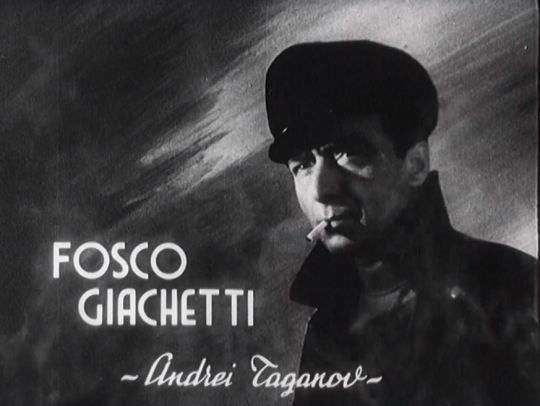







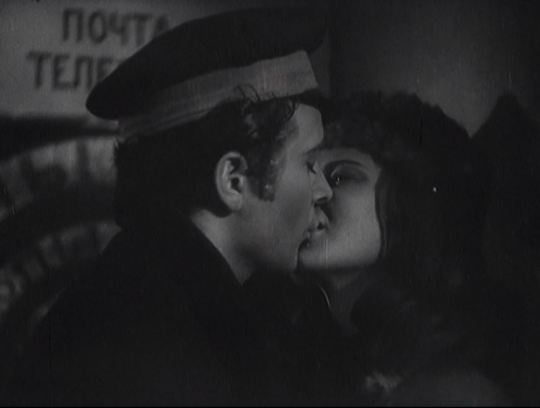

xxxxxx









R.M.
0 notes
Note
If the ghosts bosses got to be reincarnated, what do you think they’d look like in the modern age(I’m talking, like the twisted sisters, Clem(best rat boi), Fishhook, etc)?
Oh boy tough call !✨Sooo let's seeeee...
(*Low quality colouring, drawing and long post ahead (sorry), Click4Quality*)
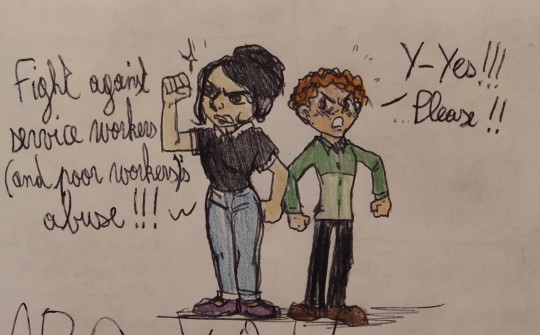
So let's start with Chambrea and Steward. They gladly took back their human form (Yeah I see Chambrea as Latino/Arabic styled, and Steward as Australian), but less gladly the fact of having to work to not get hungry. They restarted to work in services, although their experience (as for a good part of the ghosts) got them militant, and they are fighting for the service workers to get treated/respected better and better paid (between others). Chambrea (Chãlissia) is the leading type, Steward (Stuart) follows and admires her, and struggles to push their relationship to another level. They already live together.
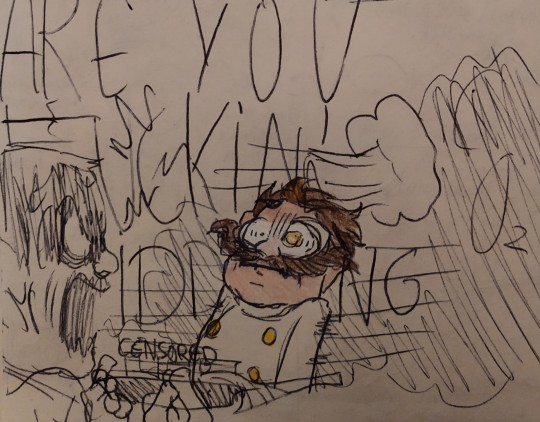
Then there's Chef Jacques Soulfflé. He of course oriented himself towards cooking, but understandably enough for those who witnessed his cooking, got fired several times, and refused to understand why ; so much that he actually attempted ''Hell's Kitchen'' to prove everyone wrong- and nearly caused Gordon Ramsay, who -figures- spectacularly blazed his @ss, to rage quit the emission. They actually had a private talk afterwards and Gordon decided to save cooking's honour and to give him private lessons. Never did he see a guy so bad at cooking but who genuinely absolutely loved cooking against all. Deserves an effort. Thanks to that Soulfflé got better and found a regular cook post. Yeah I got carried a bit far on this IK. X) Anyway so next-

Morty finally managed to open the cinema class he was planning to open before his death, and he's having the time of his life with this. He takes cheap and everyone in -elementals to elderly- and he is in a 'poor-populated' city part, so he has a lot of volunteers ; as an activity as for an actual class. He loves to communicate his passion with others, is a wonderful teacher open to everyone and loves creating shorts and movies with his students. Some of them actually succeeded as actors or staff or even directors, and often credit him. Although a bit wore out, he is really happy. Plus a good portion of the former boss ghosts like to help him with and star in his productions.
Krüller thought of becoming policeman, but chickened out and went on as a mall guard. He is great with children. He even babysits sometimes. And often stars in Morty's movies, as 'the police chief'. He's satisfied by this repetitive but calm life.
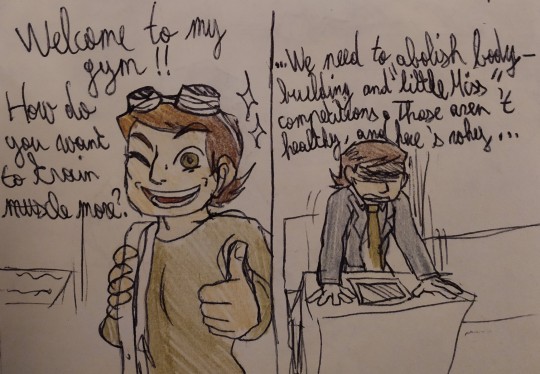

Johnny Deepend invested into an old gym and became sport coach. Between taxes and incomes, it isn't always easy but his easygoing, supportive and friendly natural attitude gets him a nice bunch of people following him and going to his gym. But on the side, he is also very engaged to ban competitions based on showing off the body, knowing way too well how destructive it is for the people, and actually even run conferences about that. He is determined.
Serpci has became a famous social media influencer and practically lives out of it (plus some beauty and fashion sideworks. She customize clothes.). Her Egyptian style, her beauty and aura and her pets snakes got her REALLY popular on any network- and leaves her targeted by many creeps of course, but her merciless way of dealing with them chicken them out (and actually is a way of outcome for her. Blackmail is powerful, but shhh.) She's militant for feminism, and against racism, cultural appropriation and above all, grave robbers (especially targeting archeologists). Remains of her pharaoh shenanigans, y'know.


Dr. Potter searched around and was taken under the wing of an association that fights to save true seeds (seeds that naturally grows back after harvesting and not having to be replaced each time like big corporations like to sell [as] 'necessary'.) He is trusted to keep and grow in number these true seeds, and in return he is taken care of, feed, and has his own house, garden and glasshouse. He is very happy.
The Triplets had to actually go to school for the first time in their lives, and if they managed to get to be adopted together (by one of the bosses, idk for this one), they had a very cynical bad surprise. They still perform during events, to show-off or at parties.
THAT is my human interpretation of Fishook. He lacks an arm and look as what white police arbitrarily view as the embodiment of ''''potential criminal''''; and now that he's human again, he's fucking pissed. As in -he freaking means business. By that I mean, he is entirely, body and soul, engaged to the whole 'Save Marine Life' cause. He raids awareness and direct missions, participates to everything and acts everywhere. Yeah, he works for the WWF. (He is also getting a bit of trouble about his cranky comportment.)
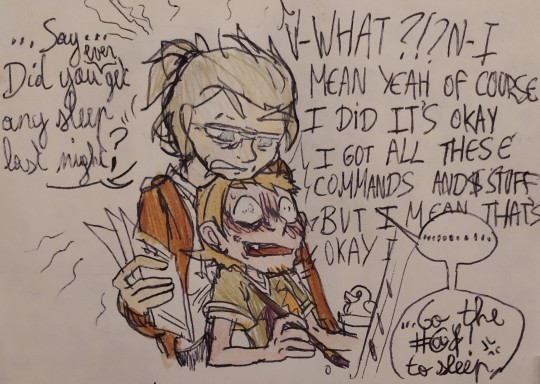
(Yeah, ship time. Why ? Because I can.)
Amadeus Wolfgeist and Clem turned into a couple representation of Tortured Artists ™. (I'll explain for Clem at some point in the future so it'd make sense, pinky swear.)
Amadeus Wolfgeist got his hair back (and I wasn't too sure of what colour to give it but heck it I'm satisfied), but was really pissed to learn that it's hard to make a carrier out of classical music nowadays. He yet decided to keep on it, determined as frick that he was to bring back the golden age, and became an independent compositor, freeing the stress generated from this work by private contract concerts. Despite his talent, he's struggling due to his dissuading stubbornness and is upset to not being able to afford his preferred nobile lifestyle. Clem has spawned up with an hyperactive syndrome, plus of his autistic condition, and is making the most money by having several jobs at the time. As a handyman/plumber, but also as a painter and visual artist, as he finally noticed how much interest and talent he had for that. He draws eyefooling artworks as a living, to situate. He kept his pet opossum and his emotional support duckies. Strangely enough, he hardly sleeps on his own impulse anymore.
They live together (for 'financial reasons' dixit Wolfgeist, y'knooow...) and complete and equilibrate each other. Clem is the one who -ironically- makes the most money, and deals with Amadeus's stress and irritation levels. Amadeus is Clem's impulse control, health, fashion, self-care and sleep schedule advisor.
Sometimes Clem seconds Amadeus on his banjo.
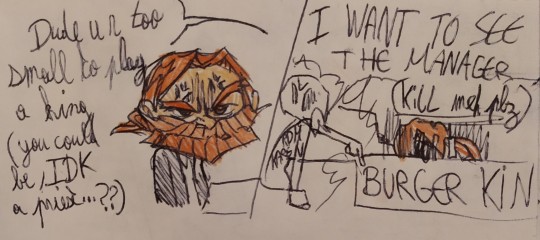
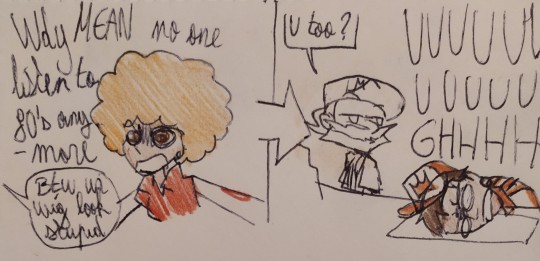
AND THEN, TO FINISH (because I literally, between other things, have no space left) we have Macfrights who tried to get hired at 'Puy du Fou' but got humiliated and turned off, and Phantasmagloria who tried to get hired as a DJ but nuts for several reasons. They both swallowed back their pride and ended up working at fast-foods. They both try as often as possible to play in Morty's movies. Macfrights likes to play the villain.
---
OKAY ! And that was about it for my headcanons about this ask. Very long post, I know but hey ! Dare I believe that it was worth it...?
Alright, thank you for your ask. That was a big one and I hope you are, too, satisfied and wish you a nice day :) .
Aaand thank you to everyone else for your attention 🎵 ! 🤗 Have a nice day~♥️
#lm3#luigi mansion 3#lm3 headcanons#lm3 steward#lm3 chef soulfflé#lm3 chambrea#lm3 morty#lm3 kruller#lm3 dr potter#lm3 triplets#lm3 serpci#lm3 dj phantasmagloria#lm3 clem#amadeus wolfgeist#clemadeus#lm3 king macfrights#lm3 captain fishook#lm3 johnny deepend#long post#answered ask
113 notes
·
View notes
Photo





Recently watched: Cleopatra (1934). Apologies to Elizabeth Taylor, but Claudette Colbert is cinema’s authoritative Queen of the Nile. Visionary director Cecil B DeMille’s lushly opulent and risqué account of the life and loves of Cleopatra VII is infinitely superior to the bloated 1963 version starring Liz’n’Dick. For one thing, DeMille tells his story in 105-minutes – a model of concision compared to the sixties version, which is a ponderous, mind-numbing four hours and twenty minutes long! The 1934 interpretation also offers the most sumptuously Art Deco of screen Cleopatras. (Which makes sense, because the Art Deco aesthetic was at least partially inspired by ancient Egyptian imagery).
The Motion Picture Production Code came into effect during production, so the eroticism DeMille was able to sneak past the censors is impressive. (We see exposed female nipples in the opening credits!). DeMille was the undisputed maestro of kinky pagan spectacle, and here proceedings reach a bonkers climax when Cleopatra initiates Marc Antony into Egyptian-style hedonism on her gilded barge. Accompanied by mounds of jewels and goblets of wine, the duo feast on skewers of “reed birds” while languorously reclining. Cleopatra lays on a lavish production number to seduce Antony, incorporating legions of homoerotic baby-oiled gladiators, slave boys in loincloths and semi-naked female concubines waving peacock feathers. The pageantry grows ever more crazed. Girls dressed as leopards cavort, crawl on all fours and then somersault through flaming hoops while a muscular male “lion tamer” in ass-baring bondage gear cracks a whip. Finally, Cleopatra gives the signal that she and Antony wish to make love, and her battalion of underlings swing into action. Giant billowing silk curtains unfurl to give the couple privacy. Dancers ritualistically perform. Flower petals rain from the sky. The camera pulls back to reveal the galley slaves rowing the barge to the beat of a drum. The segment is a fever dream of orgiastic depravity and a pinnacle of Golden Age Hollywood camp nirvana!
Colbert makes for a coolly calculating and seductive Cleopatra. Her slinky and revealing ensembles (heavy on gold lamé and exposed flesh) are by costumier Travis Banton, the genius who also dressed Paramount’s other divas like Marlene Dietrich and Mae West at the time. His creations all seem to focus attention on Colbert’s boobs, and weirdly anticipate the wild looks Bob Mackie would create for Cher in the seventies. Bear in mind Colbert made It Happened One Night, Imitation of Life and Cleopatra all in the same year. She was effortlessly, stylishly confident in screwball comedies, melodramas and historical epics. So why doesn’t Colbert get the kind of acclaim for this range in the way her peers like Davis, Crawford and Stanwyck routinely do? Anyway, as Marc Antony rugged British leading man Henry Wilcoxon matches Colbert for pulchritude and sex appeal (those shortie togas showcase his powerfully muscled thighs beautifully). Which reminds me of an anecdote in Boyd McDonald’s essential 1985 volume of essays Cruising the Movies. McDonald offers an account shared by a sailor friend who was once picked-up by Wilcoxon. The actor gave him a lift from San Francisco to Los Angeles, which involved an overnight hotel stopover. Apparently, Wilcoxon “expressed himself in “animal groans”” and “dropped him at the gardenia-scented Biltmore, sore-assed but satisfied.”
#cleopatra#claudette colbert#cecil b demille#henry wilcoxon#old hollywood#golden age hollywood#golden age of hollywood#lobotomy room#kitsch#boyd mcdonald
11 notes
·
View notes
Text
Definitions of Movies
Film is a form of visual communication characterized by images that move and are usually accompanied by sound, but not always. It is a medium for showcasing a wide variety of experiences, ranging from everyday life to high art. Cinema, the Latin word for "cinema," is a general term for the film industry. Here are three definitions of the word "movie." "disturbia (2007)"
CinemaScope combines two different film technologies. In 1960, cinemaScope was used for the first time for the movie "September Storm." This was a blow-up of a non-anamorphic negative. The next year, another film combining 3D and CinemaScope was released: Space Attack. It was actually shot under the title of The Adventures of Sam Space. In both cases, cinemagoers were treated to an immersive visual experience that took them out of their seats and into the film's world.
A more recent version of the film is the World 3-D Exposition, organized by Sabucat Productions to celebrate the 50th anniversary of the 3-D craze. At Grauman's Egyptian Theatre, over thirty films from the "golden age" were screened. This era of 3-D was preserved by filmmaker and preservationist Robert Furmanek, who spent fifteen years preserving films. The throngs of the sold-out crowds caused many stars to attend the exhibit.
Another film that was adapted from the musical was "In Tune With Tomorrow". This was the first film to use stereophonic sound in the United States. The film was produced by Douglas Sirk and starred Howard Keel and Kathryn Grayson, the MGM songbirds. The production was originally shot in black and white, but was reshot in color the next year for the World's Fair. In addition to its original black-and-white release, In Tune With Tomorrow was released in 1953, but it went out flat despite its starring cast and high budget.
A film's impact on the film industry is controversial. Some studies have concluded that positive film reviews can influence movie-going decisions. In addition, the impact of film reviews on prestige films, especially art and dramas, is even more important. If a movie has a poor reputation from leading critics, audiences are likely to feel less interested in watching it. This may not be a direct cause of the recent Oscars, but it can increase the likelihood of an awards-worthy movie in the future.
Another popular genre is science fiction. The genre dates back to the silent film era and has always captured audiences' imaginations. Early sci-fi films focused on the scientific and outer space. The genre has been a popular one throughout cinematic history, as it highlights the advancements of mankind while wrestling with higher concepts. In fact, science fiction has a long history of influence on pop culture, from horror to fantasy. This type of film is one of the most influential in the industry.
0 notes
Text
I wanted to do a post on my favorite historical eras that I love reading about, but for whatever reason never did. But while I was wandering across Youtube I found a fun Tag by Kassidy Voinche. Which is obviously this one: Historical Fiction Book Tag. Here we go!
Why do you like to read historical fiction?
I love history and to read historical fiction for me is like a sneak peek into the people’s lives in different eras. it’s so fascinating!
What was the first historical fiction book you read?
I don’t remember what was the exact first historical fiction book I’ve ever read but Gone with the Wind was one of the first books I’ve read very very very long time ago.
Where do you draw the line for “historical fiction” and contemporary?
The 70’s are historical fiction to me, but the 80’s and up are contemporary. I think because I was born in the 80’s make it contemporary.
Have you read a book set in each of these eras?
1600’s and before
Counted With the Stars by Connilyn Cossette – Based on the Biblical Exodus, from a PVO of a young Egyptian girl who is forced due to the circumstances to follow the Hebrew in the desert.
Shadow on the Crown by Patricia Bracewell – The story of Emma of Normandy when she is forced to marry a man she despises.
The Midwife of Venice by Roberta Rich – The captivating story of a Jewish midwife and her journey to rescue her husband from slavery.
1700’s
The Kitchen House by Kathleen Grissom – Set in the late 1700’s on a tobacco plantation in Virginia and follows the life of a family and their slaves.
Kit by Marina Fiorato The book follows a journey of an Irish woman as she looks for her disappeared husband.
1800’s
The first image that comes to my mind when I think about this era; Grey streets of London, horse carriages, oil lamps, ladies wearing fancy hats, gentlemen in tailored suits, Scotland Yard detectives. It’s the golden age of romanticism and mysticism!
The Moonstone by Wilkey Collins – The story circles around a cursed diamond that mysteriously disappeared and the investigation to find it.
A Bride in the Bargain by Deeanne Gist – Alone in the world, the main protagonist must move across the country to find her purpose and love of course.
The Mirk and Midnight Hour by Jane Nickerson – A haunting love story and suspenseful thriller based on the ancient fairy tale of “Tam Lin.”
1900’s and WWI
All Quiet on the Western Front by Erich Remarque – This is one of the most heartbreaking stories of soldiers during the horrible battles in France.
Atonement by Ian McEwan – One of my all-time favorite books of love, sisterhood, betrayal, forgiveness, and atonement of course.
1920’s-30’s
There’s something so very glamorous and fun about the 20’s; Jazz music blossomed, clubs, new modern flapper style for women, Art Deco, telephones, automobiles and cinema, fancy celebrities and movie stars!
Mrs. Houdini by Victoria Kelly – The exciting and mystical story of Harry Houdini’s wife Bess.
The Diviners by Libba Bray – An enchanting, mysterious and sometimes even creepy story of few very different people trying to solve a crime in 1920’s New York.
Water for the Elephants – The emotional, dramatic and tragic love story that takes place in a circus.
Z The Begining of Everything – Zelda Fitzgerald is the personality that perfectly represents the Jazz age to me. Her lifestyle is what made the 20’s iconic.
1940’s and WWII
Very dramatic and heroic era. There are so many stories about people’s bravery to tell, on all fronts, and I love them all. Whether they told by Polish Jews, American and allied pilots, army nurses, Normandy, Pearl Harbor, Stalingrad, Auschwitz and many more.
The Color of Secrets by Lindsay Ashford – An interracial romance of a British war widow and an American soldier as they struggle during WWII.
All the Light We Cannot See by Anthony Doerr – Another WWII novel that follows a blind French girl and a German orphan boy.
The Diplomat’s Wife by Pam Jenoff – A love story set after WWII when Martha was rescued from a Nazi Camp by an American soldier.
1960’s-1970’s or later
The Help by Kathryn Stockett – A story of three determinate women who fight for a change in their hometown.
The Great Alone by Kristin Hannah – A story of a family looking for refuge in a small Alaskan town but the solitude life turned out not as they pictured.
What was the last historical fiction book you read?
I’m currently reading the third book in Out of Egypt series by Connilyn Cossette: Wings of the Wind. And I absolutely love it. Never read any book based on the biblical stories. This series follows Egyptians and Hebrew during the Exodus.
What’s your favorite historical fiction cover?
Difficult to pick, I like simple covers that are atmospheric enough to catch my attention.
What’s your favorite historical fiction?
I can’t name one. In fact, every book I’ve mentioned in this tag are the ones I really enjoyed. However, I want to point out Philippa Gregory and her novels of the Tudor epoch, and Surah Sundin who writes about WWII. They’re both my auto-buy authors in this genre.
Historical Fiction Book Tag I wanted to do a post on my favorite historical eras that I love reading about, but for whatever reason never did.
0 notes
Text
The (Questionably) Golden Age of Hollywood
By: Sofia Guanzon

Originally posted on Tumblr
Ah, hollywood. Haven’t we all been pulled into the glamour and romance of Hollywood at some point in our lives? I know I have. Particularly, I have always been a fan of films from an era that we’ve now come to know as the Golden Age of Hollywood. This period encompassed the 20s up to the 60s. The most notable films from this era have also become some of the most iconic films of all time such as Breakfast at Tiffany’s, Rebel Without A Cause, Casablanca, Some Like It Hot and more. Of course where would this age be without the stars of the time, stars we’ve come to venerate as icons of fashion, art and culture like Audrey Hepburn, Marilyn Monroe and Marlon Brando. The peak of this Golden Age were the 50s and 60s, modern cinema was evolving and Hollywood spearheaded the trends to which we owe our films today.

Photo from the Los Angeles Public Library Photo Collection
For the sake of specifics, I will be focusing on popular films released in 50s and 60s. In retrospect one may may wonder: what is Hollywood’s secret? How did they produce such great films during a time of social, political and economic change, when entertainment would usually be the least of people’s priorities? The answer is the commonality of these films: the spectacular ignorance present in all of them.

Photo by UPI/Brettman/Corbis Newsphotos
In order to fully make sense of what I mean, let’s take a little history lesson! America has had a long history of racial divide between white and black people. The Civil Rights Movement motioning for equality started in 1954 and ended in 1968. The main goals of the movement were to end racial discrimination and segregation and to protect the rights of African-Americans. Before that, African-Americans were slaves and constantly mistreated by their white peers. The most mind-blowing thing probably is the historical parallels this momentous point in history had with cultural milestones in the film industry. While caucasians were flourishing in la la land, black people all over the country were fighting for their right to go to school and use the toilet. Martin Luther King Jr.’s I Have A Dream speech was delivered in 1963, the same year the most expensive film ever to be made at that point - Cleopatra, with Elizabeth Taylor, one of the highest earning (white) actresses of the time starring as an (definitely not white) Egyptian queen was released.

Original photo by Margaret Bourke-White
People today love to reminisce on the “simpler times” when looking back on old films from this era. The romance of it all and dramatization of the 50s and 60s are mostly based on films preserved from this time. When the world watches these movies, they do not look beyond the entertainment being flashed before them. We only see the beauty of the actress, the dreaminess of the leading man and the love affair they get themselves into with catchy music to accompany it all. It is so easy to get sucked into the insipid void of shallow entertainment which we deem as escape, when in the long run it is almost historical revision. No one watches Audrey Hepburn singing Moon River in Breakfast at Tiffany’s and thinks: where are the black people? Every single film from this era starred white people. The only film that even tried to include them in the narrative was To Kill A Mockingbird and they were simply a plot device then, a problem for the white knight in shining armor to defend them and still be proclaimed hero of the story. Aside from the African-American voice being excluded, other historical events of the time are overshadowed by the glamour of these films such as the Cold War and Korean War. In these two events, America displays its military presence and solidifies itself as a superpower of the world with its fast economic growth and recovery from World War II. They gain profit from exploiting other countries and their citizen reap the rewards. Still, we overlook everything and still celebrate America for... their movies. Isn’t that astounding?

Originally posted by primogif
Nostalgia is a trend ironically amongst millennials, the grandchildren of the generation who actually lived it. Due to the photos, films and fashion of old hollywood glamour it comes as no surprise that people see this time as the “good old days”. The lack of social media also leads people today to believe that life was generally better back then. The impact the films of that time on the audience is an example of Baudrillard’s simulacrum. We are taught to believe that what is popular and celebrated is right. It is perceived that these famous representations of the 50s and 60s are the only significant sides of the story, that they are accurate representations of reality. The overwhelming impact it’s had on society and culture blurs the lines between what is true and what is simply fiction. Realizing all this now one must ponder, was the golden age of Hollywood really golden at all?
0 notes